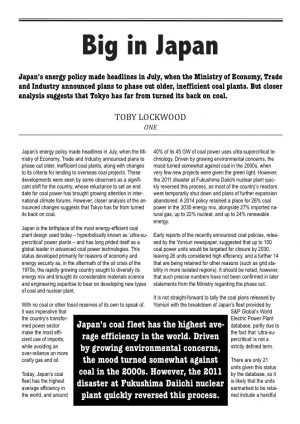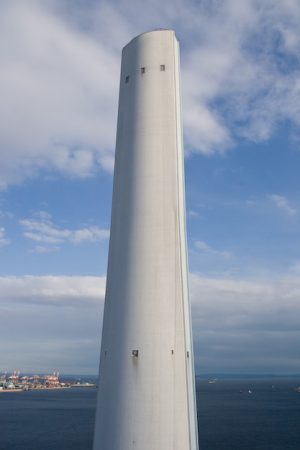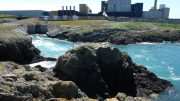 Japan’s energy policy made headlines in July, when the Ministry of Economy, Trade and Industry announced plans to phase out older, inefficient coal plants, along with changes to its criteria for lending to overseas coal projects. These developments were seen by some observers as a significant shift for the country, whose reluctance to set an end date for coal power has brought growing attention in international climate forums. However, closer analysis of the announced changes suggests that Tokyo has far from turned its back on coal.
Japan’s energy policy made headlines in July, when the Ministry of Economy, Trade and Industry announced plans to phase out older, inefficient coal plants, along with changes to its criteria for lending to overseas coal projects. These developments were seen by some observers as a significant shift for the country, whose reluctance to set an end date for coal power has brought growing attention in international climate forums. However, closer analysis of the announced changes suggests that Tokyo has far from turned its back on coal.
Japan is the birthplace of the most energy-efficient coal plant design used today – hyperbolically known as ‘ultra-supercritical’ power plants – and has long prided itself as a global leader in advanced coal power technologies. This status developed primarily for reasons of economy and energy security as, in the aftermath of the oil crisis of the 1970s, the rapidly growing country sought to diversify its energy mix and brought its considerable materials science and engineering expertise to bear on developing new types of coal and nuclear plant.
With no coal or other fossil reserves of its own to speak of, it was imperative that the country’s transformed power sector make the most efficient use of imports, while avoiding an over-reliance on more costly gas and oil.
Today, Japan’s coal fleet has the highest average efficiency in the world, and around 40% of its 45 GW of coal power uses ultra-supercritical technology. Driven by growing environmental concerns, the mood turned somewhat against coal in the 2000s, when very few new projects were given the green light. However, the 2011 disaster at Fukushima Daiichi nuclear plant quickly reversed this process, as most of the country’s reactors were temporarily shut down and plans of further expansion abandoned. A 2014 policy retained a place for 26% coal power in the 2030 energy mix, alongside 27% imported natural gas, up to 22% nuclear, and up to 24% renewable energy.

Isogo Thermal Power Plant, Yokohama City (Japan). Photo credit: Σ64
Early reports of the recently announced coal policies, released by the Yomiuri newspaper, suggested that up to 100 coal power units would be targeted for closure by 2030, leaving 26 units considered high efficiency, and a further 14 that are being retained for other reasons (such as grid stability in more isolated regions). It should be noted, however, that such precise numbers have not been confirmed in later statements from the Ministry regarding the phase out.
It is not straight-forward to tally the coal plans released by Yomiuri with the breakdown of Japan’s fleet provided by S&P Global’s World Electric Power Plant database, partly due to the fact that ‘ultra-supercritical’ is not a strictly defined term.
There are only 21 units given this status by the database, so it is likely that the units earmarked to be retained include a handful of the newest units which are merely ‘supercritical’ plants – probably those built since around 2000. These would amount to around 21 GW, together with an unknown capacity from the 14 less-worthy units which have also avoided the firing line.
So, while 100 units sounds like a lot of generators to close, these mainly consist of very small units – often used by heavy industry to supply on-site power – and they probably amount to only around half of Japan’s existing coal capacity. Some significant heavy weights do seem to be included in the cull, including older supercritical plant from the 1980s and early 1990s, but these would be nearing the end of their design life in 2030 in any case.
Much of the recent criticism of Japan’s energy policy has centred on the fact that 14 new coal plants are currently under construction in the country. Ten of these are state-of-the-art, efficient units in typical Japanese style, while two more showcase the latest incarnation of a potentially more efficient technology known as integrated gasification combined cycle (IGCC), in which coal is first converted to a combustible gas and then used to power a gas turbine. These will add a further 8.6 GW to the coal capacity remaining in 2030, bringing the total to at least 30 GW. Although this could still represent a significant reduction, such a scale-back does not seem wildly inconsistent with Japan’s existing ambitions, which sees coal’s contribution to the electricity mix fall from 32% to 26%.
In short, Japan’s coal plans mainly seem to represent an acceleration of an existing trend towards developing a highly modern coal fleet, which will retain its role as a key part of a diversified energy mix. The possibility of adding even more ultra-supercritical or IGCC capacity has also not been ruled out. The older units pegged for closure have probably long jarred with the country’s own self-image as a trend setter in coal technology. However, phasing out so many small coal plants will be far from straight-forward, especially given so many of them are associated with heavy industry – presumably long accustomed to accessing cheaper power than available from the grid. Japan is actively exploring several options for reducing the CO2 emissions of its existing coal assets while avoiding closure of the plants.
One pathway which has already been well trodden in Europe is an either partial or complete conversion to burning biomass such as wood pellets. Another, more unusual idea, is to equip coal boilers with the capability to burn ammonia; this chemical is seen as a more manageable form for exploiting the decarbonisation potential of cleanly produced hydrogen. Japanese company Mitsubishi is a leading provider of technology for capturing CO2 from coal power plants, and there is growing interest in converting captured CO2 into useful products – known in Japan as carbon recycling.
It is informative to compare Japan’s status with that of Germany, which has a similar level of CO2 emissions per capita (unlike nearly all other European nations, this is higher than China’s). Despite embarking on a much-publicised energy transition since 2010, Germany boasts a coal power capacity similar to Japan’s, including a wave of new, largely ultra-supercritical plants completed within the last decade.
German efforts to decarbonise have also been slowed by political reaction to the Fukushima disaster, which accelerated existing plans to phase out nuclear power with a new deadline of 2023. Chancellor Merkel has recently showed signs of a shift in the country’s strong stance against carbon capture and storage, but this technology still seems unlikely to be applied to the power sector.
Unlike Japan, Germany has set a date for the complete phase out of coal power, although the choice of 2038 will allow most of the recently built plants to complete a typical 25-year economic life. While Japan seems unlikely to join Germany and many other countries in this pledge, the Asian nation’s arguably more pragmatic approach to cleaning up its coal habit has by no means closed the door on decarbonisation.
Toby Lockwood




